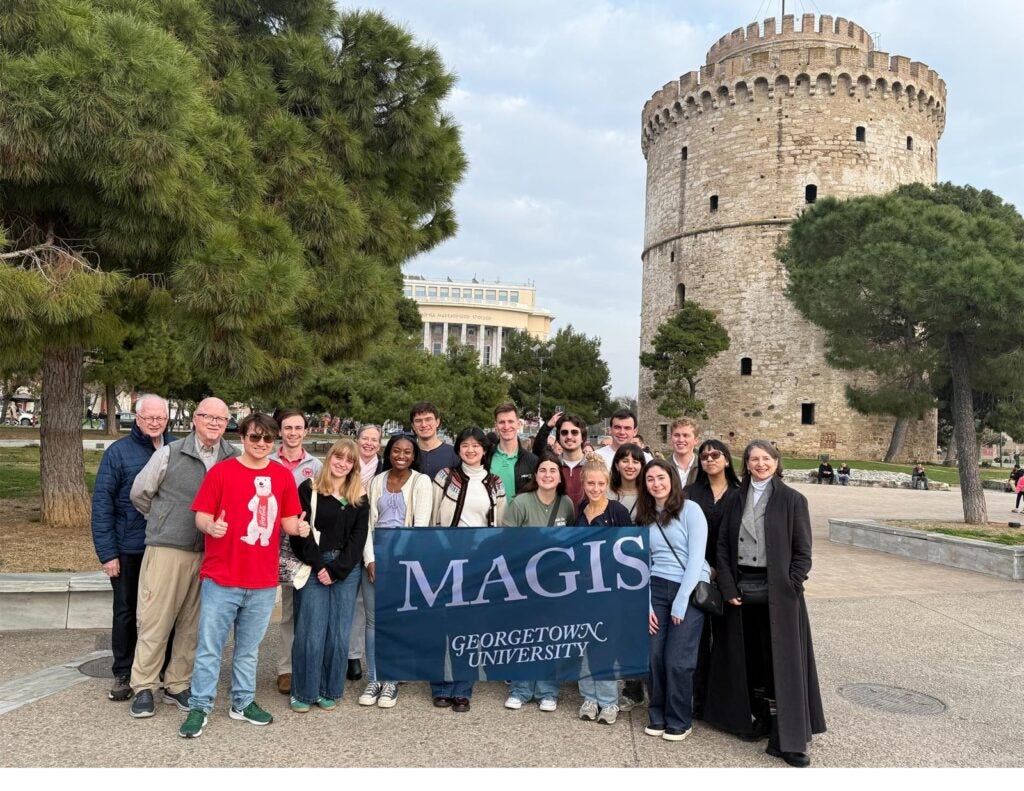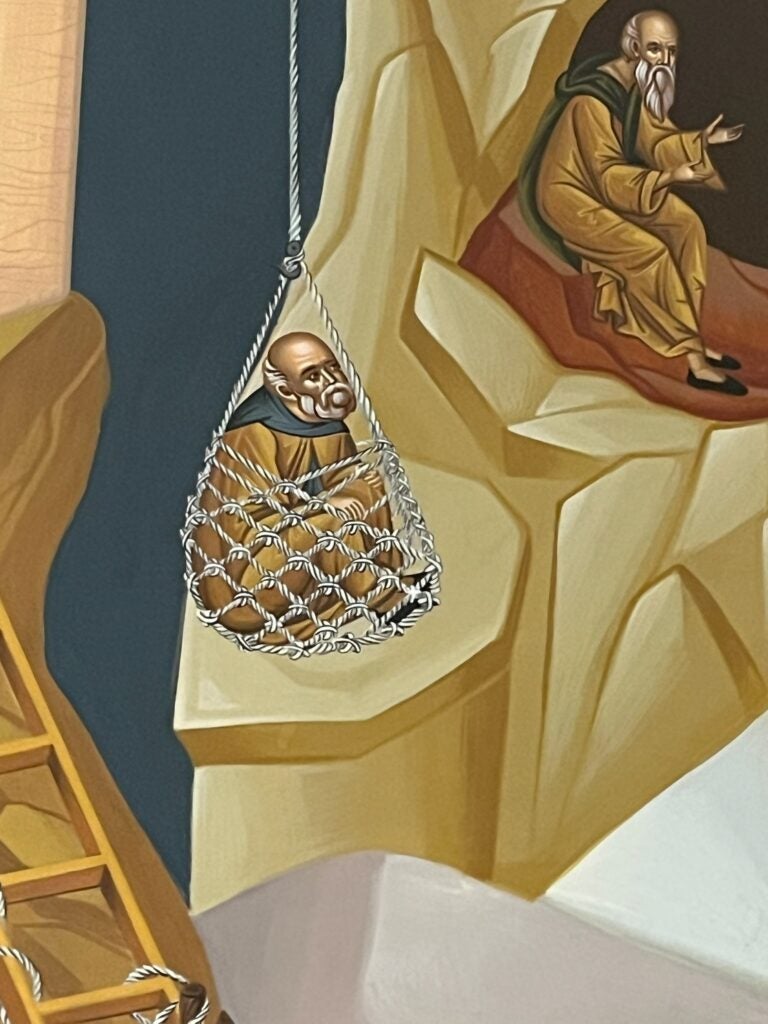Magis Immersion Seminar: Reading St. Paul in Greece
Photo Essay by Christina Pan (C ’27)
One of the more unique ways that Georgetown University supports academic excellence, cura personalis, and holistic education is through the Magis Immersion Seminars. Each topic of the experiential learning opportunity includes rigorous in-class learning that explores the theological, historical, political, and other facets of a culture, then invites the students to immerse themselves in the culture with an on-the-ground weeklong trip during Spring Break. Students return from their Magis trip with deep reflections and rewarding, once-in-a-lifetime experiences. We asked several students to share their thoughts about the preparation, the expectations, and the lasting impressions they felt about their Magis Seminar trip. Below is the photo essay reflection by Christina Pan (C’27) who visited Greece in March, 2025.

Our group pauses for a photo in front of the White Tower of Thessaloniki. From left to right: Prof. Alan Mitchell, Father Ryan Maher, Anthony Sharafullin, Dean Rosamilia, Ana Tucholski, Prof. Julia Lamm, Faith Donaldson, Josh Wiesenfeld, Olivia Li, Sebastian Zuba, Shelby Flynn, Benjamin Fishbein, Sophia Toback, Athena Tsialas, Con Lane, Madeline Williams, Teddy Tibbs, Christina Pan, Ioanna Kopsiafti. Photo credit: unknown.
We arrived in Thessaloniki after a long travel day, including a layover in Munich. A stranger took a photo of our group in front of the White Tower of Thessaloniki, overlooking the beautiful seaside that reaches the Aegean Sea. The air was fresh, and the people walked leisurely. Families of all ages strolled by in the waning evening. We had started to adjust our pace to the Greek way of life.
After the rushed connections and sterile corridors of airports, the Thessaloniki waterfront felt like stepping into another dimension of time—one measured not by schedules but by the rhythm of waves against the shore and the unhurried conversations of locals. We found ourselves unconsciously slowing our steps, taking deeper breaths, allowing conversations to unfold without rushing to conclusions. The Greek concept of siga-siga (“slowly-slowly”) wasn’t just a quippy saying, but an invitation to a different way of experiencing the world.
We later joined the locals at a seaside taverna. Plates of fresh seafood arrived at our table, and glasses clinked in toasts to new discoveries.

A field of ruins and wildflowers, this space in Corinth recalled the reflective passion of Paul’s letters to the Corinthians.
We reached Corinth, and the scenery felt just as Paul’s letters described—charged with something fervent and eternal. I remember taking a photo after visiting a small museum a bit off the main path. The fence nearby had given way, so people could wander into an open field that overlooked the ruins. I walked down a slope and found myself standing before a sweep of yellow poppies scattered among crumbling stones. In the middle of the flowers stood an elderly couple, still and quiet. For a moment, the scene seemed unreal—like I had stepped into a painting I didn’t yet know the name of, full of warmth and suspended time. It was an ethereal sort of place, and I remember thinking I might never again witness something so perfectly still.
The ancient ruins scattered among vibrant wildflowers created a juxtaposition of mortality and renewal that embodied the spiritual tensions Paul addressed in his letters. Standing there, one could almost sense the apostle’s presence, his words to the troubled Corinthians echoing across millennia. The distinctive quality of light in Greece—clear and golden—bathed everything in a luminosity that transformed the ordinary into something transcendent. From my vantage point on the hillside, I could see how the isthmus connected two worlds, much as Corinth itself had been a crossroads of cultures and ideas.
The elderly couple moved slowly through the poppies, their silver hair catching the late afternoon sun as they bent occasionally to examine a particular flower or fragment of stone. I lingered there longer than planned, watching the couple’s unhurried pilgrimage through the poppies.

This image is from a monastery in Meteora, depicting how a pulley system allowed the monks of the monastery some connection to the world outside.
This photo depicts the monks’ pulley system, which they used to pull various foods and people up to the monastery. The ancient pulley system stands as a testament to the ingenious solutions the monks developed for their isolated existence atop Meteora’s towering rock formations. Before stairs were carved into the cliffs in the 1920s, this was their only connection to the world below.
We had a fascinating conversation with a Grecian monk who explained his calling to his monastic life. At 19 years of age, he had originally told his mother that he planned to go on a small vacation. He in fact did not go on a small vacation: he became a monk, and twenty or so years later, he is still at the same monastery. One student aptly joked that he would like to become a monk, simply because it would not require the same I-9 and tax forms that accompany modern employment. Seeing different cultures–modern and ancient alike–living side-by-side throughout Greece added a layer of perspective throughout the trip.

This photo shows how beautiful architecture and iconography are utilized to create a space of reverence and humility. Photo Credit: Benjamin Fishbein (C’26).
We visited the Archbishop of Athens and toured the interior of the Archbishop’s church. We visited a variety of churches, from the opulent to the humble. Throughout our pilgrimage, we were struck by the way each church, regardless of its grandeur or simplicity, created a distinctive atmosphere of reverence. The Archbishop explained how the architecture and iconography of each space were designed to elevate the spirit while remaining grounded in local cultural expressions of faith.
As evening approached, we shared a meal of traditional Greek fare, continuing our theological discussions well into the night. The hospitality we received mirrored the warmth we had encountered throughout our journey across Greece’s sacred spaces.

Before we left, we enjoyed our final dinner at GH Attikos, a restaurant overlooking the Acropolis. From right to left: Teddy Tibbs, Christina Pan, Athena Tsialas, Sophia Toback, Olivia Li, Anthony Sharafullin, Sebastian Zuba, Benjamin Fishbein. Photo Credit: Julia Lamm, professor of theology.
Every dinner on the MAGIS trip was served family style with hearty servings of ouzo and wine, along with hours of conversations about everything: theology, literature, art, history, politics, economics, classics, psychology (the majors of the students represented here) to less abstract topics from food and the occasional debates about New Yorkers vs Americans in Greece, and more.
The conversations that had begun tentatively weeks ago now flowed with the ease of true companionship. A classics major debated the merits of Aristotle with a theology student, while others compared the Byzantine mosaics we’d seen to Renaissance art. Professor Lamm sparked a lively discussion with her question about how various creative disciplines might perceive the same scene differently—a studio artist noticing the light and shadow across passengers’ faces, a theologian seeing each person as a journey in progress, and a writer imagining the stories hidden behind each pair of eyes on the crowded train.
There was a moment of silence at dinner as this was our last day, each of us knowing we were returning changed in ways we hadn’t yet fully understood. Athens sprawled below us, a palimpsest of civilization that had wrestled with the same eternal questions we had been exploring. Boundaries between past and present, student and scholar, and stranger and friend had all faded into something timeless.
Christina Pan (C’27) is studying Comparative Literature at Georgetown University. All photo credits are hers unless otherwise noted.
- Tagged
- Greece
- Magis
- Spring Break
